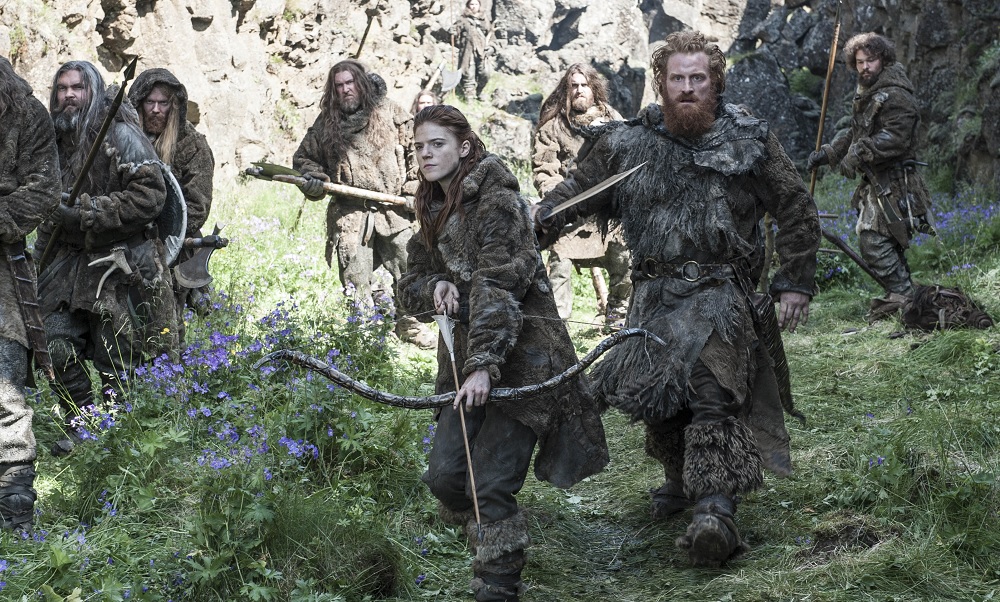
They call themselves the “Free Folk” but the Westerosi who reside south of the Wall refer to them as “wildlings”. The very name, despite being derogatory, seems to imply that they aren’t civilized or good people: that they are violent savages. They do have a bad reputation among the people of the Seven Kingdoms, who would mostly prefer them to be kept in the other side of the Wall.
In the same way there are many Noble Houses and different cultures in both Westeros and Essos, the wildlings aren’t an homogeneous group but rather distinct groups of people.
The King-Beyond-the-Wall Mance Rayder united them under a single banner for a time, but they are normally divided in different clans and tribes. Sometimes they mind their own business and other times they fight with each other.
Rather than just offering a character summary, I’ll go over the different tribes and clans, some of which have appeared in the show. Many of them, particularly in the novels, don’t have very detailed descriptions, only the bare minimum to differentiate them from one another -but that’s enough to make them intriguing, and allows for fun speculation.
The wildling faction that gets more attention and development in both the novels and the show is the vanilla one, perhaps because they’re more similar to the people south of the Wall, and therefore more relatable for us readers/viewers in a way, unlike those with more freaky habits or appearances (would Jon fall in love with a cannibal Ygritte? Most likely not!). Not to mention that, in the case of the TV adaptation, having wildlings with complicated make-up or costumes would be hardly worth the expense – they might be nice to look at, but the money could be better used somewhere else.
However they’re a part of what makes George R.R. Martin’s work so rich and inviting. I for one wouldn’t like to be invited for dinner by the Ice-river Clans, but would I like to learn more about them? Absolutely!
Without further ado, let me introduce you to some of these charming fellows.
Cave Dwellers
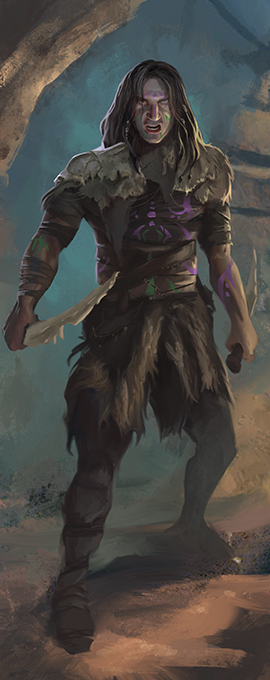
Art by Paolo Puggioni
Game of Thrones RPG
Cave Dwellers (or “Cave People”) seem to have a pretty self-explanatory name. They are free folk who live in caves. But alas, ever since they joined Mance’s army, there han’t been a lot of cave-dwellin’ for them.
Their presence in the novels is minimal at best, and it’s the same case in the screen adaptation, in which they do appear, but it’s a blink-and-you’ll-miss-it affair. And that is because they don’t have any lines: we are just told they joined Mance’s army in Season 3, and in Season 5 they are among the other wildlings at Hardhome. They are identifiable because of their painted faces.
With so little information, we don’t have much to discuss about them. Do the other wildlings like them or hate them? What are their habits? What’s their motivation for joining Mance? Escaping the White Walkers or finding warmer and more comfortable caves in the lands south of the Wall?
We can assume, based on their choice of habitat, that they are maybe more primitive than other clans or tribes. But perhaps not. Caves can be comfortable after all, with proper planning and the right amount of commodities. I doubt their caves are empty spaces and that they sleep in the floor, in which case I hope they have at least a rug or two, made with snow bears’ or shadowcats’ pelts.
Nightrunners
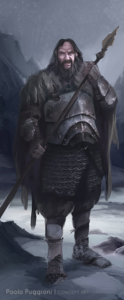
Art by Paolo Puggioni
Game of Thrones RPG.
Not much is known about the Nightrunners. That’s not to say we don’t really know anything other than they were enemies of the Hornfoot clan, and both clans fought each other until Mance put an end to the conflict when he recruited them. That’s all there is about them in the books, and they didn’t make it to the show.
A rather simple interpretation, based on their clan’s name alone, is that they have nocturnal habits and are really fast. Or that they (some of them at least) work as a an unit that moves and attacks at night while their enemies are sleeping, which strategically speaking is a great advantage to have in any army. Or it could just be that they dress in dark colors that make it difficult to spot them at night time, or that they live in a region where polar nights are a common occurrence, as it happens in some places of our very own world.
Hornfoots
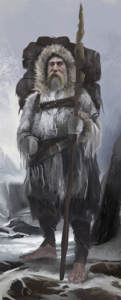
Art by Paolo Puggioni
Game of Thrones RPG.
The members of the Hornfoot clan are like the less-whimsical, more violent version of hobbits. And that is because they refuse to use footwear – no shoes, no boots, no nothing. The soles of their feet become as hard as leather and turn black as a consequence of strolling around in the hard and rocky region near the Frostfangs.
As is the case with the Nightrunners, information is scarce at best, and the adaptation didn’t make use of the Hornfoots, so they’re basically defined by their contempt towards footwear and their feud with the Nightrunners.
It’s a shame in a way that Martin didn’t develop these clans a bit more. It would’ve been fun if they had traits such as lopping off the feet of their enemies or that it’s offensive for Hornfoots to receive shoes as presents. Maybe they show their disapproval at their leaders by throwing boots at them. Too silly? Remember there are members of House Tully with Muppet names.
Frozen Shore Men
Despite the information about them is limited, they manage to be one of the most picturesque clans. They are basically the wildling version of Inuit people, since fishing and riding on sleds are part of their routine.
Their sleds and chariots are made with walrus bones pulled by huge savage dogs (as big as direwolves!), and their outfits are also made of animal parts, such as their skins, bones, antlers and tusks.
You’d think that if one of them doesn’t like fish, that person would be really unhappy since the menu consists of mostly seafood, but the Frozen Shore people aren’t as isolated as they appear to be – they wouldn’t have been able to join Mance otherwise.
Other wildlings do not seem to like them much: Tormund actually warns Jon about them, because of their savagery.
I wish we could have seen at least one or two of them in the screen adaptation, if only because they’d really stand out among the rest of the free folk and would really drive home the fact that, despite the wildlings share many similarities with the people who live south of the Wall (the same gods, the same language, even many of the same prejudices or social structures), their culture can be vastly different.
It was probably not worth the expense and the effort of making their overly ornate attires, only for a few seconds of screen time. The Cave Dwellers were easier, since they only paint their faces.
Ice-river Clans
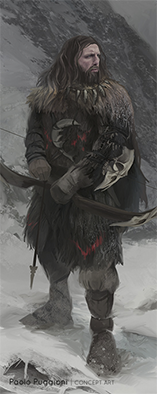
Art by Paolo Puggioni
Game of Thrones RPG.
The Ice-river clans aren’t very popular even among their own wildling peers, because of their culinary habits. Turns out they’re cannibals, or at least that is what is said about them.
The place where they live, so close to the Land of Always Winter, is so inhospitable that it’s unlikely they can find many animals or grow anything to eat, so in order to survive they have resorted to attack other wildling tribes: the Frozen Shore Men specifically.
Mance figured out a way to convince both clans to stop warring and join his army. And while I agree that the details of how Mance managed to do that aren’t really important for the story to work, I would have loved to get some nuggets of information instead of just being told that Mance is a skilled negotiator.
How do you convince a group of half-feral individuals who allegedly like to eat people to march with you and not create any disturbance on the way to the Wall and beyond to the south? Promising them more tasty and plump prey?
Despite it was a risky gamble for Mance, it makes sense to keep an unit of cannibals in your army, as some sort of shock and terror unit who’s not only out to kill you, but also to eat you and your relatives. Had the wildlings won the Battle of Castle Black, what Mance would’ve done with the Ice-river clan is anyone’s guess. Let them loose to create further chaos in Westeros? Trying to regulate their eating habits? Probably just feed them dissenters or political enemies?
Thenns
The Thenns either got the short end of the stick or they were improved when it comes to the screen adaptation, since they got merged with the Ice-river clan. It’s quite the odd combination, since the Thenns are the most advanced clan among the wildlings in the books: they don’t eat human flesh, they have some mad metallurgy skills and actually forge their own weapons and armor instead of just looting them from the corpses of rangers.
They also follow a leader known as the “Magnar of Thenn”, and not only that: the title is hereditary. Most wildlings feel open contempt for nobility and “kneelers”, so that a clan implementing this kind of custom so inherent to the feudal society of Westeros is really surprising.
Thenns are uniformly dressed and organized when it comes to warfare. They are as organized and disciplined as a military unit can get, which is yet another difference with most other wildling tribes that look more like ragtag bands of looters.
Perhaps the considerable alterations made to Styr (the former “Magnar of Thenn”) and his men were to make them more scary and a bigger threat. A group of tall, heavily scarred cannibals certainly works better in the show. We wouldn’t have Alliser Thorne’s rousing speech otherwise: “Do you want to fill the belly of a Thenn tonight?”
After the death of Styr (who in the books died after falling into a trap and in the show was killed by Jon Snow in single combat), his son Sigorn becomes the new Magnar of Thenn.
Giants
The giants are, as their name indicates, really tall humanoids. Not quite towering kaiju monsters, but certainly big enough to squash humans without much effort.
Like the direwolves and other creatures that once roamed free in Westeros, the conflict with the First Men forced giants to go beyond the Wall and stay there, which turned them into fictional creatures from songs and fairy tales with the passing of the years.
Though I don’t think there are geniuses among them (they seem to be somewhat primitive, at least when it comes to their weapons, which consist of clubs, logs or stones), they are more intelligent than they seem. They speak the Old Tongue and ride mammoths (how badass is that?).
When Jon is brought to Mance’s camp, we (as readers and watchers) find out that giants are in fact real.
As with the most savage wildling clans, I feel curious about the way negotiations between the giants and Mance went down. How were they convinced to march alongside the wildlings? I suppose the answer for all these questions can be summed up in one word: Others. The widlings all must have realized their survival depended on their success of being able to go south of the Wall. And yet, having to compromise and work with people with vastly different ideologies and habits (some of them actual enemies) isn’t a pill that is easy to swallow.
It’s nothing short of impressive that Mance was able to forge an alliance with the giants, knowing they have every reason to be resentful of men.
There has been little giant presence in the books, but in the show we got Wun Wun (whose name is a reference to former Giants quarterback Phil Simms, whose jersey number was 11) wreaking havoc in two major battles, Hardhome and the Battle of the Bastards, before sadly falling victim to one of Ramsay’s arrows.
A curious fact that didn’t make it to the show is that Wun Wun is a vegetarian. We don’t know if it was by choice or if all giants do prefer veggies to meat. Perhaps they do, and all the stories about man-eating giants were just made up (or embellished at least), in order to make them more scary.
Mance Rayder
Clearly not a clan or a tribe, but I couldn’t leave the King-Beyond-the-Wall out of this article.
I’ll be honest, when Ciarán Hinds was cast as Mance Rayder, I was confused.
Hinds is a really good actor, but the Mance I had in my mind looked very different. A man of slender appearance and clothing more similar to those of the “crows” of the Night’s Watch, to reference his previous allegiance. I was sold on Hinds’ Mance after his first scene in the show, so there’s that.
An element of Mance’s character that didn’t make it to the show was his love for playing music and singing. In fact, it is revealed that during the events of A Game of Thrones, Mance managed to climb the Wall and travel to Winterfell to play the lute at the feast celebrated for Robert Baratheon. He’s not recognized by anyone, and later returned to his place beyond the Wall, having accomplished a feat worthy of Bael the Bard himself.
This aspect of Mance of being a music enthusiast is similar to Rhaegar Targaryen. I’m not drawing any connections here between the two of them, but I’d like to point out how this is good character development: it humanizes them. They aren’t just fixated on war and politics: they do like to engage in more mundane and seemingly trivial activities. The little screen time Hinds got and the need of the story to move forward makes me see why we didn’t get a musical number, but even a passing reference could’ve been nice.
But the biggest loss in the transition from book to screen has to be Mance’s backstory, and why he abandoned the Night’s Watch: after being wounded by a shadowcat during a ranging, Mance’s wounds were tended to by a wildling woman who also repaired his torn black cloak with red fabric.
Upon his return to the Wall, he was ordered to dispose of his old, tattered cloak and get a new one. Mance would have none of it and decided to join the wildlings so he could live his own way, later gathering the biggest (living) army the North has ever seen as King-Beyond-the-Wall. Show costume designer Michele Clapton intended to give Mance his iconic cloak, but it was ultimately decided he wouldn’t have it. It’s a shame, but I can understand why it was jettisoned: without the proper context or enough time to explain it, the meaning of the tattered cloak is lost. Or remains a wink to book readers, at best.
Mance has still a role to play in the novels, but in the show, he’s already dead.
And so it concludes our little trip around the different wildling camps!
Personally, I would’ve loved to see the Frozen Shore Men (and Women) in the show, with their sleds made of bone and big feral dogs, but I understand the budget wouldn’t have allowed it- not even our beloved direwolves are safe from getting cut in favor of the dragons!
If anything, the material is ripe for a spin-off. Surely at least one of the five planned series currently in development at HBO has a wildling or two among the cast. And if there are no dragons, you can use the creature budget on snow bears, direwolves, shadowcats and more giants! The lands beyond the Wall certainly aren’t lacking in potential for excitement and violence.
The different clans and tribes allow for a variety of scenarios, and the lack of detail allows for the screenwriters to fill in the blanks and go wild (no pun intended) with their own ideas and creativity.
I can’t wait to see what’s in store, not only for Season 8 (which probably won’t have much regarding wildlings with the exception of Tormund), but beyond: the two remaining books, and the future series that hopefully will be as engaging as Game of Thrones!
The post From the Maester’s Desk: The Wildlings Beyond the Wall appeared first on Watchers on the Wall.
Via http://watchersonthewall.com

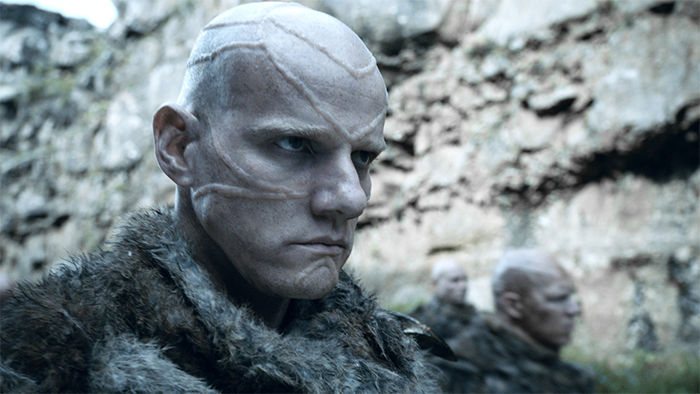
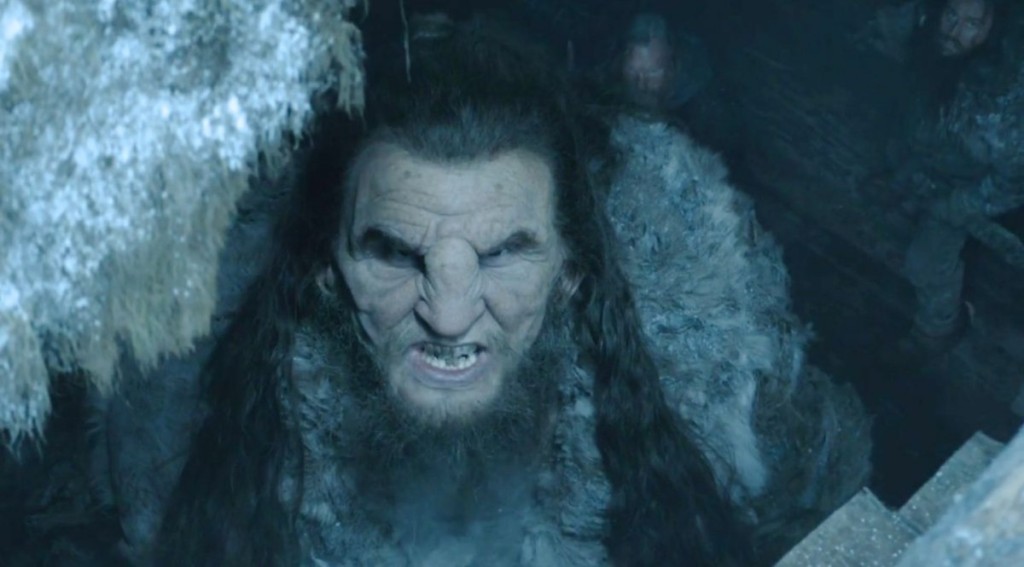
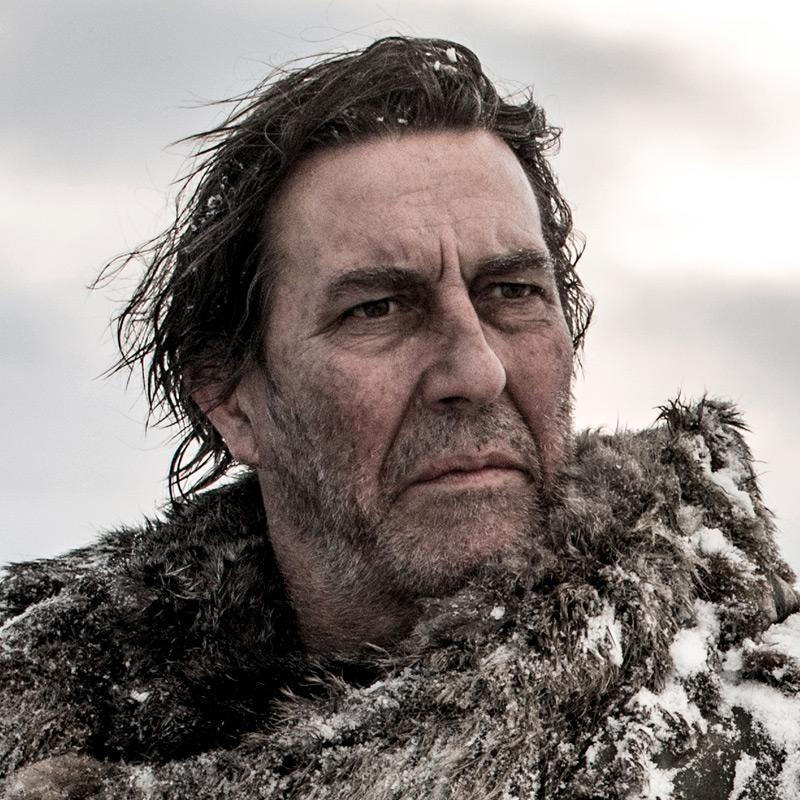
No comments:
Post a Comment